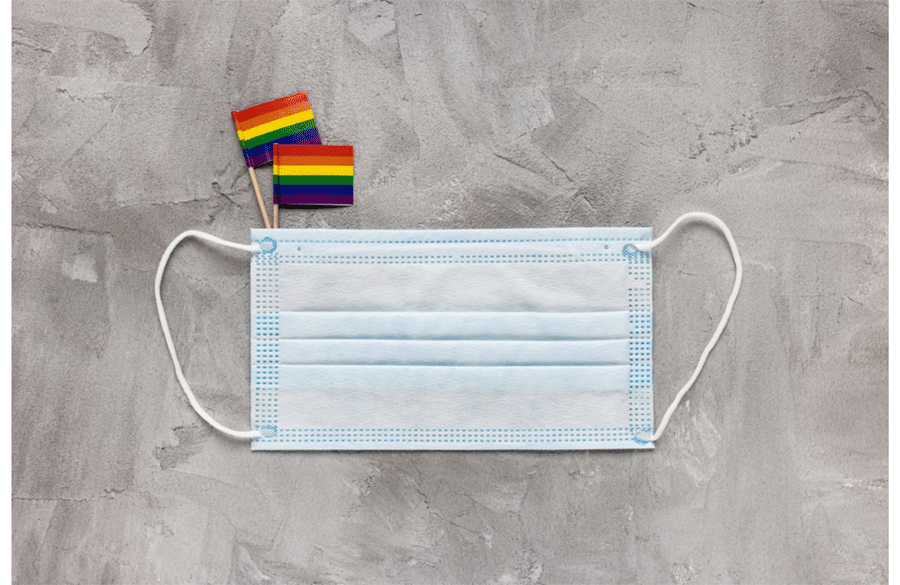The moments that can negatively shape an LGBTQ+ person’s experience with the health care system often happen before they even see a doctor.
“We could talk all day long about screenings, disparities and outcomes—the things that health care professionals want to talk about—but [many LGBTQ patients are] not even going to the doctor in the first place. That’s where this crisis really starts and ends,” says Jessica Halem, who works as a consultant for health care organizations and served as the inaugural LGBTQ Outreach and Engagement Director at Harvard Medical School. “The discrimination and barriers that LGBTQ people face from even going to a doctor’s office is the greatest risk we have in our lives.”
A 2017 poll conducted by NPR, Robert Wood Johnson Foundation, and the Harvard T.H. Chan School of Public Health found that nearly one-in-five LGBTQ+ Americans avoid the doctor out of fear they will be discriminated against. Another survey, from the National LGBTQ Task Force, found that 28 percent postponed medical care when sick or injured due to discrimination and disrespect. In the same survey, 28 percent of LGBTQ+ people said they were subjected to harassment in medical settings.
Halem says LGBTQ+ people often face intolerance and feel stigmatized in clearly bigoted ways and other times in ways that may not seem as obvious. “Even a doctor just saying to an LGBTQ person, ‘I don’t know anything. I wasn’t taught anything. I have no idea what to do with you,’ it’s so dehumanizing. We know that patient will never come back, and we’ve heard these stories over and over again,” she says.
But it’s not just the doctors and nurses that can be problematic. Halem says these patients feel stigmatized when the valet moving their car misgenders them or the person at the coffee shop gives them a weird look when they say their name. Even the website and marketing materials of a health care organization can be off-putting.
“The website has all these heteronormative people that look happy. I want to see some punk rock, rainbow tattooed people. I want to see people who look like my community on your website. I want to easily find an LGBTQ friendly doctor. Every tiny little point of the experience has to be affirming, free of stigma, not be heteronormative, should embrace gender diversity, and then we’re lucky if we can get naked in the doctor’s office for the actual medicine,” Halem says.
Awareness, education and all hands-on deck
One of the biggest challenges in health care with regards to caring for the LGBTQ+ community is an overall lack of awareness and education within organizations. Halem says many times executives think only the doctors and nurses working in specific areas need to pay attention to LGBTQ needs, but it needs to be an all-hands-on deck mentality.
Jacqueline Ortiz, Director, Health Equity and Cultural Competence at ChristianaCare, says organizations must be proactive when trying to create a more inclusive environment for these populations. “Just because we’re not overtly discriminating isn’t nearly enough. You’ve got to go beyond that stance to really say, not only do we not discriminate but we’re doing proactive work to make sure that we’re actively welcoming and inclusive,” she says.
The Human Rights Campaign named the ChristianaCare an “LGBTQ Healthcare Equality Leader” in 2020. Ortiz says that recognition came from a number of initiatives and work that the health system has done to create a more inclusive environment. Along with equal LGBTQ employee benefits and its community engagement efforts, ChristianaCare also has a wellness clinic that provides behavioral support to patients transitioning genders and has primary care physicians who specialize in hormone therapies for transitions.
In this regard, Halem says that every system should be adding checkboxes to its website that provide a directory of clinicians who are LGBTQ+ and transgender friendly. “We don’t know what that means because there is no certificate. No one is getting graded but allowing providers to self-identify their interest in LGBTQ and transgender medicine would be wonderful,” Halem says. “It’s a no brainer.”
At ChristianaCare, what’s been especially important in creating a more inclusive environment is employee education, Ortiz says. “We’ve had hundreds of hours educating staff on LGBTQ+ issues. Educating our new nurses, employees, and members of different service units throughout the system on interacting safely with LGBTQ+ patients, and understanding the difference between sexual orientation and gender identity,” she says. “There really has to be a push towards educating providers, both on what are the different issues that could be encountered by LGBTQ+ patients in terms of their own biases and assumptions…and then the basic issues of health for these folks.”
Halem says that health systems need to ensure they are internally doing right by their LGBTQ+ employees before taking on the rest of the community. She points to the example of a hospital that spent a million dollars on an ad campaign for Pride month, only to find out LGBTQ+ employees didn’t feel welcome within. “We can’t be there for LGBTQ patients if we aren’t there for our own employees first,” Halem says.










